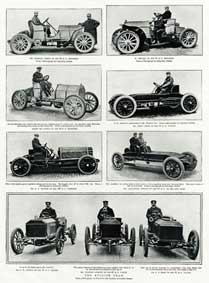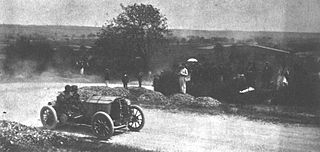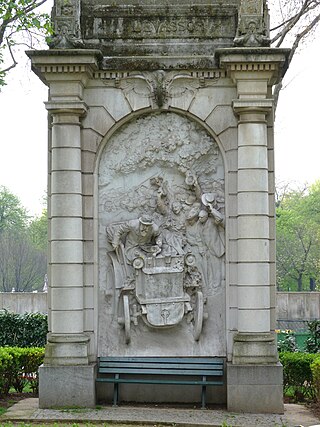1903 in sports describes the year's events in world sport.

1901 in sports describes the year's events in world sport.
Grand Prix motor racing, a form of motorsport competition, has its roots in organised automobile racing that began in France as early as 1894. It quickly evolved from simple road races from one town to the next, to endurance tests for car and driver. Innovation and the drive of competition soon saw speeds exceeding 100 miles per hour (160 km/h), but because early races took place on open roads, accidents occurred frequently, resulting in deaths both of drivers and of spectators. A common abbreviation used for Grand Prix racing is "GP" or "GP racing".

As one of three Gordon Bennett Cups established by James Gordon Bennett, Jr., millionaire owner of the New York Herald, the automobile racing award was first given in 1900 in France.

The 1906 Grand Prix de l'Automobile Club de France, commonly known as the 1906 French Grand Prix, was a motor race held on 26 and 27 June 1906, on closed public roads outside the city of Le Mans. The Grand Prix was organised by the Automobile Club de France (ACF) at the prompting of the French automobile industry as an alternative to the Gordon Bennett races, which limited each competing country's number of entries regardless of the size of its industry. France had the largest automobile industry in Europe at the time, and in an attempt to better reflect this the Grand Prix had no limit to the number of entries by any particular country. The ACF chose a 103.18-kilometre (64.11 mi) circuit, composed primarily of dust roads sealed with tar, which would be lapped six times on both days by each competitor, a combined race distance of 1,238.16 kilometres (769.36 mi). Lasting for more than 12 hours overall, the race was won by Ferenc Szisz driving for the Renault team. FIAT driver Felice Nazzaro finished second, and Albert Clément was third in a Clément-Bayard.

Julien Jean Chassagne was a pioneer submariner, aviator, and French racing driver active 1906-1930. Chassagne finished third in the 1913 French Grand Prix; won the 1922 Tourist Trophy and finished second in the 1925 Le Mans Grand Prix d'Endurance - all in Sunbeam motorcars. He was second in the 1921 Italian Grand Prix with a Ballot, and set speed records and won races at Brooklands and hill climbs internationally.

The 1908 Grand Prix season was the third Grand Prix racing season. An international economic recession affected motor-racing with fewer races and smaller fields. However, in consequence, it also saw an increase in the number of smaller cars and voiturette racing. This gave close racing between the teams from Lion-Peugeot, Sizaire-Naudin and Delage. Both the major races in Europe, the Targa Florio and French Grand Prix, had precursor voiturette races, and along with the Coupe des Voiturettes, the honours were shared between those three manufacturers. This year’s Targa Florio had a small, but quality, field. Vincenzo Trucco won for Isotta-Fraschini with better mechanical reliability, after a close duel with the FIATs of Felice Nazzaro and Vincenzo Lancia.
The 1910 Grand Prix season was the fifth Grand Prix racing season. Because of the ongoing international economic recession, there were no Grandes Épreuves held. The American Grand Prize was held in Savannah.
The 1911 Grand Prix season consisted of Grand Prix races in the United States and Europe. It was a significant year as European racing gradually came out of the doldrums. A Grand Prix was held in France again. The first Indianapolis 500 was held at Indianapolis Motor Speedway, joining the American Grand Prize as a leading race.
The 1912 Grand Prix season saw Grand Prix motor racing in Europe and the United States. The growing economic confidence and interest from car manufacturers saw bigger fields and more races in the season. The French Grand Prix was held for the first time since 1908 and staged at Dieppe. The American Grand Prize was held in Milwaukee, moving from its previous home in Savannah.

The Paris–Madrid race of May 1903 was an early experiment in auto racing, organized by the Automobile Club de France (ACF) and the Spanish Automobile Club, Automóvil Club Español.

The Paris–Bordeaux–Paris Trail race of June 1895 is sometimes called the "first motor race", although it did not fit modern competition where the fastest is the winner. It was a win for Émile Levassor, who came first after completing the 1,178km race in 48 hours, almost six hours before second place. However, the official winner was Paul Koechlin, who finished third in his Peugeot, exactly 11 hours slower than Levassor, but the official race regulations had been established for four-seater cars, while Levassor and runner-up Louis Rigoulot were driving two-seater cars.
The 1913 Grand Prix season consisted of Grand Prix races in Europe and the United States. Once again, the Peugeot works cars were the team to beat, continuing their success. This year the French Grand Prix was held in Amiens. The ACF introduced a fuel-economy formula for the race to discourage bigger-engined cars. Peugeot drivers Georges Boillot and Jules Goux claimed a 1-2 victory for the company after Zuccarelli had been killed in practice.

The 1922 Grand Prix season had several notable events during the year. The AIACR governing body brought in a 2-litre formula for Grand Prix. French companies brought out straight-8 engines for their cars but it was FIAT's 6-cylinder engine that took the trophies. Veteran Felice Nazzaro won the French Grand Prix, held near Strasbourg. It was a tainted victory though, as Nazzaro's nephew was killed when his FIAT's suspension broke in the latter stages of the race. An almost identical accident also happened to team-mate Pietro Bordino, though he was only slightly injured. Pierre de Vizcaya's Bugatti finished second, nearly an hour behind.

The 1923 Grand Prix season was part of a watershed year for motor racing that saw significant advances in motor-racing engineering, design and events. Fiat's chief designer, Guido Fornaca, developed the 805, the first supercharged car to win a Grand Prix. Benz appeared with the first mid-engined racer and, along with Bugatti and Voisin, produced some of the first efforts at aerodynamics on racing cars. With the United States also adopting the 2-litre formula, Harry Miller could use the smaller engine size to design the first single-seater race-car, ideally suited to American oval racing.

Rolland-Pilain was a French car maker formally established on 4 November 1905 at 95, rue Victor-Hugo in Tours by François Rolland and Émile Pilain.

Léon Théry was a French racing driver, nicknamed "Le Chronometer", who won the premier European race, the Gordon Bennett Cup, in both 1904 and 1905.

Charles Jarrott was an English racing car driver and businessman. Jarrott raced from 1900 to 1904, winning the 1902 Circuit des Ardennes race and competing in the 1903 and 1904 Gordon Bennett Cup races. He was the chair of the Motor Cycling Club's Annual Dinner at the Trocadero on Saturday 12 December 1913. He co-founded a car import firm in 1902 and was a founder member of the Automobile Association, serving as chairman in 1922.

Hubert Le Blon was a French automobilist and pioneer aviator. He drove a steam-powered Gardner-Serpollet motorcar in the early 1900s, and then switched to Hotchkiss for both the world's first Grand Prix at Le Mans in France and the inaugural Targa Florio in Sicily. At the Vanderbilt Cup races on Long Island he competed for the US driving a Thomas.

Lucy O'Reilly Schell was an American racing driver, team owner, and businesswoman. Her racing endeavours focused mainly on Grand Prix and rallying. She was the first American woman to compete in an international Grand Prix race and the first woman to establish her own Grand Prix team.




















